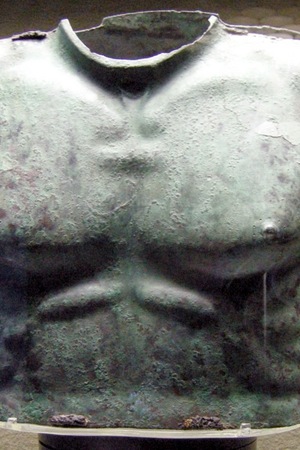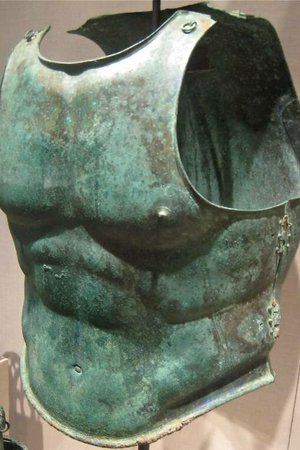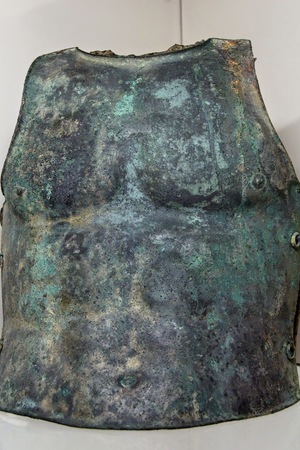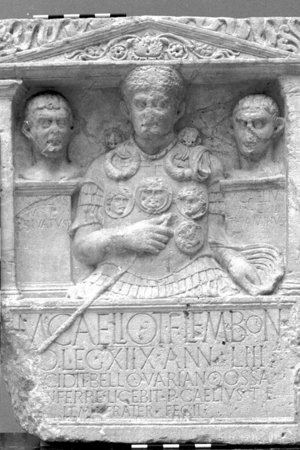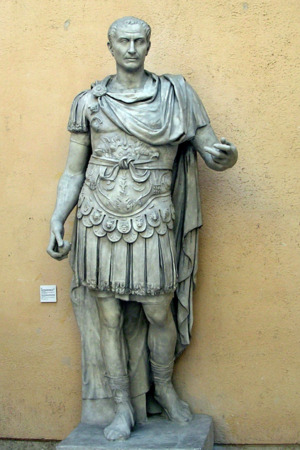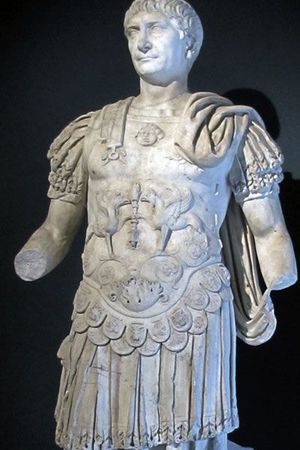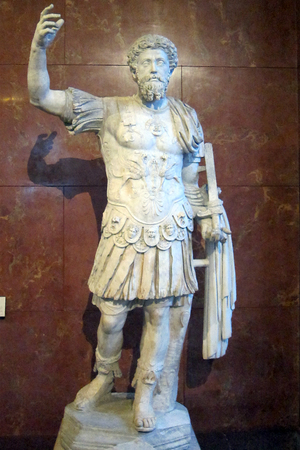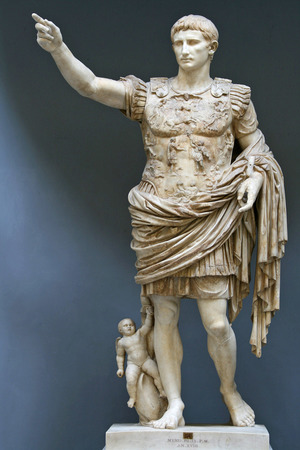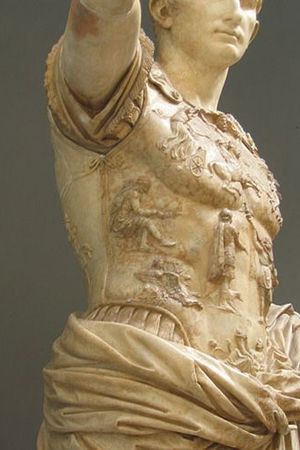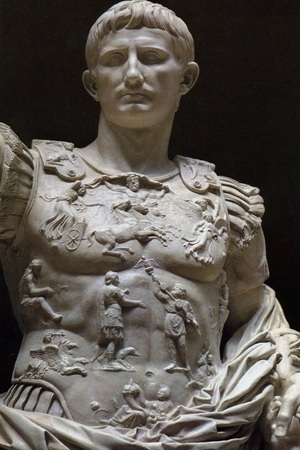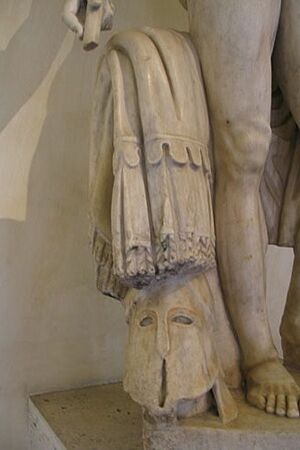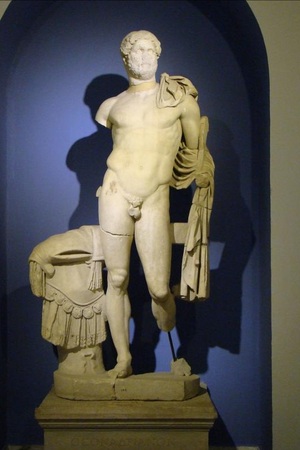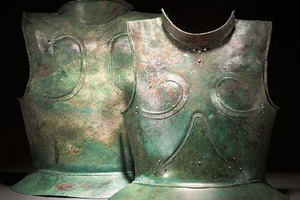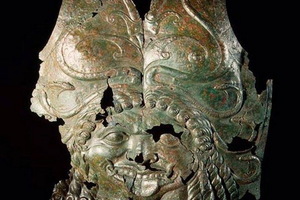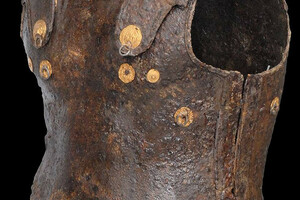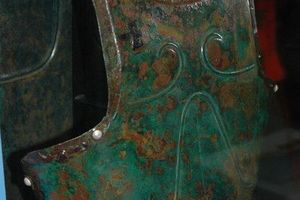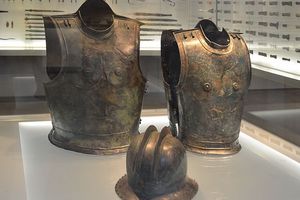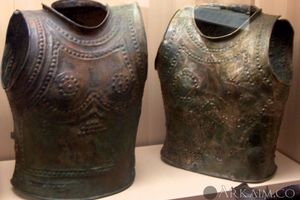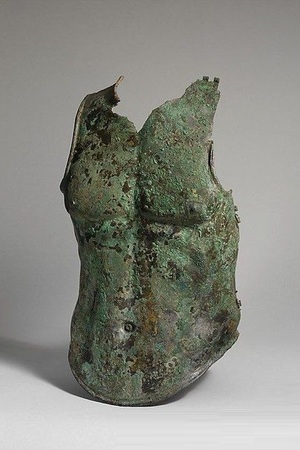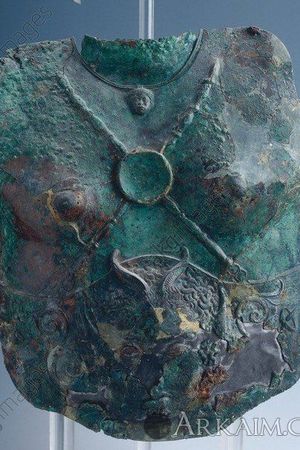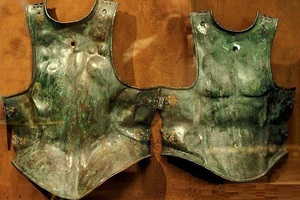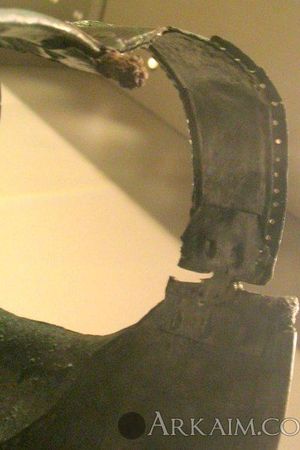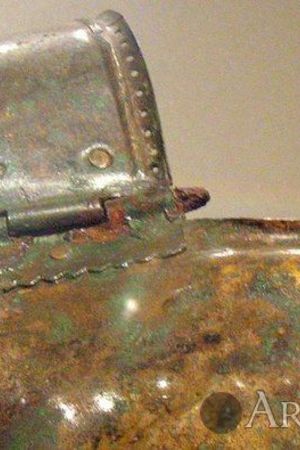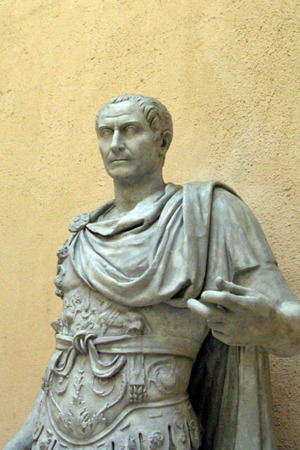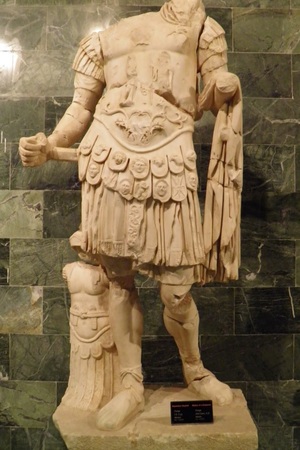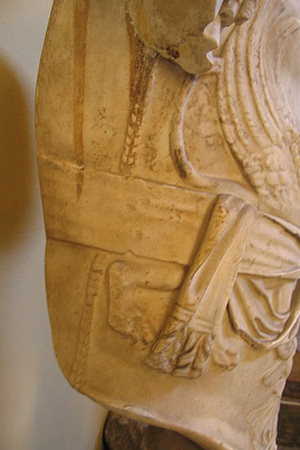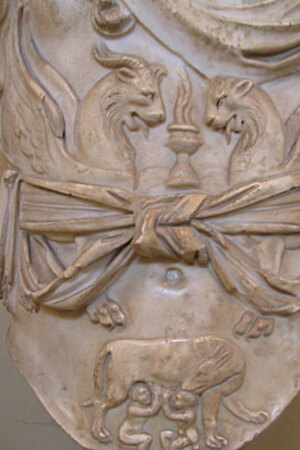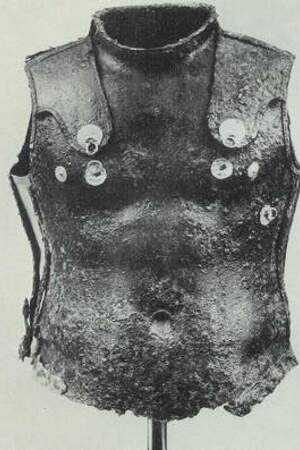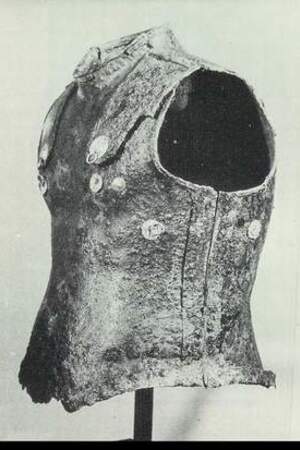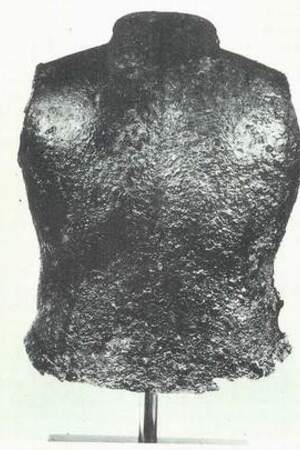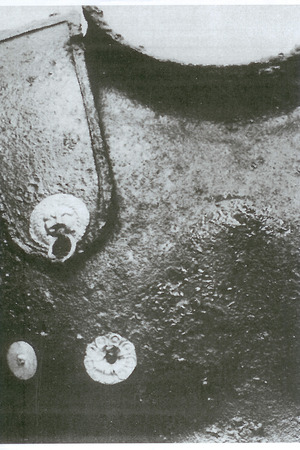Lorica musculata
Lorica musculata (Latin: lorica musculata, literally "muscular cuirass") is a type of ancient roman armor similar to a cuirass, consisting of anatomically shaped segments usually made of two interconnected pieces.
Early types of cuirasses and the precursors of Roman musculata were made of bronze and consisted of chest and back plates that extended to the hips, fastened together with straps. This type of armor is often referred to separately as a cardiothorax. The plates were often engraved with relief representations of the male torso.
Similar armor was also used by other ancient civilizations, such as the Greeks and Celts. In Greece, this type of armor was called a thorax, and it influenced the development of lorica musculata, which featured relief engravings of the chest, abdominal muscles, and back. Later, when musculata became exclusive to high-ranking military officials after being replaced by lorica hamata for ordinary legionnaires, the musculata became highly decorated with embossed designs. They were also worn over a lavishly decorated undershirt called a subarmalis, which further enhanced the protective properties of the armor. During the Imperial period, lorica musculata became primarily a ceremonial military attire.
The majority of musculata findings date back to the Republican era, and they were predominantly made of bronze alloys.
Musculata in Ancient Rome
Among the lower-ranking military officers in the Roman army, the centurions were known to wear lorica musculata. Interestingly, they started wearing it even during the Republican era, and this tradition continued unchanged into the Imperial period. Unlike legates and emperors, the musculata worn by centurions was not adorned with elaborate embossing, but instead, phalerae were worn over it.
The most richly engraved lorica musculata variants belonged to emperors and legates. The most common set of engraving were Jupiter spikes on the shoulder segments, the Gorgon Medusa in the upper part of the chest, and two griffins near the abdomen. That composition hasn't changed much since the Republic era. But there were other options, for example, images of gods, sphinxes, eagles. Also, a special fabric belt was often tied over the lorica musculata called Zona Militaris. In the middle of the lorica musculata, at the navel level, the belt was tied into a special knot, which is sometimes called as "Herculean". It was primarily the attribute of legates and emperors.
The most striking example of an Emperor depicted in musculata is the two-meter statue of Augustus from Prima Porta. It was discovered in 1863 on the villa of the emperor's wife, Livia. The villa was found near Rome on the Via Flaminia in the area of Prima Porta. In ancient times, the villa was known as Ad Gallinas Albas. The statue is a copy of the original Roman bronze made by order of the senate in 20 BCE. Historians believe that the statue's face bears a high degree of resemblance to Augustus, although certain facial features are considered idealized. The statue depicts the future emperor delivering a speech to ten thousand of his supporters on the Forum, urging them to wage war against his political rival, Mark Antony. This speech turned out to be unsuccessful as his audience refused to fight against the loyal former associate of Caesar, Antony. It was also influenced by the fact that at that time, Octavian was too young and lacked sufficient authority to declare war. The lavish musculata of the emperor is adorned with depictions of allegorical figures such as Earth and Sky, the Sun and Moon, and in the center, a Parthian warrior humbly returning the captured Roman standards to the god Mars. An Amor figurine riding a dolphin at the feet of Augustus serves as a reminder of the divine lineage of the emperor, descended from Venus and Aeneas, as celebrated by Vergil. The reverse side of the musculata is poorly preserved, but traces of embossed decorations can still be seen, which is rare for this type of armor. The right side of the panel shows a wing and a trophy. Made of marble, it is housed in the Chiaramonti Museum, Vatican (inv. 2295).
An interesting theory suggests that some parts of the musculata were made of leather rather than bronze. This is indicated by some reliefs where the musculata is depicted lying next to its owner, folded in a specific manner. It should be noted that this image may not depict the musculata itself, but rather the subarmalis.
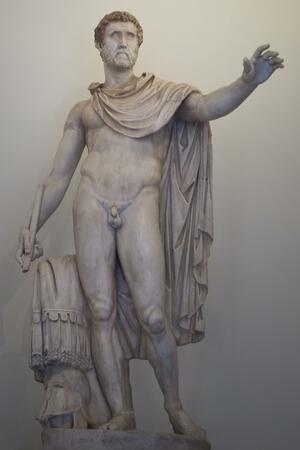 A statue of Emperor Antoninus Pius with a leather lorica musuclata or subarmalis. Rome, National Roman Museum. 2nd century CE
A statue of Emperor Antoninus Pius with a leather lorica musuclata or subarmalis. Rome, National Roman Museum. 2nd century CEGreek Cuirasses
The two-piece cuirass appeared in Greece during the Bronze Age. It gained widespread use in the 8th to 6th centuries BCE. However, due to its high production cost, it did not become a mass-produced type of armor, as it faced competition from linen armor. Only about one in every ten warriors could afford such armor. Modern reconstructions of this type of armor weigh around 6 kg.
Craftsmen made the cuirass from bronze by hammering a sheet of metal on a stone mold. The armor consisted of front and back plates fastened together at the shoulders and sides with inserted hinges or straps. When assembled, the cuirass had a barrel shape that roughly imitated the musculature of the male torso. Both plates had cutouts for the warrior's throat, arms, and waist. The lower part of the cuirass had a so-called bell-like shape due to its characteristic wide flaring. This shape allowed the warrior to sit without removing the armor. The cuirass itself was short and protected the warrior's torso only up to the waist.
Decorative elements included embossed and engraved figures, which formed complete compositions in the most luxurious and expensive examples. Anatomical motifs were also frequently used in embossed decorations.
Of particular note is the rare variation of iron musculata with gold fittings found in the region of Epirus in the Prodromi tomb. It dates back to 290-270 BCE.
Celtic Cuirasses
One of the oldest analogues and precursors to lorica musculata can be considered Celtic cuirasses. They featured entirely different symbolic images and anatomy. The "abs" were rarely depicted, but traditional Celtic patterns were frequently seen. They were also made of bronze and mostly dated to the 4th-6th centuries BCE.
Related topics
Lorica Hamata, Subarmalis, Centurion, Legate, Hoplite, Celts, Ancient Greece, Linothorax, Octavian Augustus, Сardiophylax
Literature
- Erika Simon: Der Augustus von Prima Porta. Bremen, Dorn 1959. (Opus nobile 13)
- Paul Zanker: Augustus und die Macht der Bilder. München, C. H. Beck 1987, ISBN 3-406-32067-8
- Britova N. N., Loseva N. M., Sidorova N. A. Roman sculptural portrait, Moscow: Iskusstvo Publ., 1975.

 Gallery
Gallery






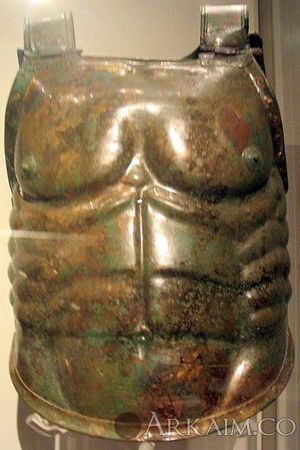 Lorica musculata. Lanuvium's warrior tomb. Bronze, there are traces of leather and linen. Maximum height: 40.8 cm, shoulders 50 cm, width: 30 cm, overall thickness: 26 cm. 490-480 year BCE
Lorica musculata. Lanuvium's warrior tomb. Bronze, there are traces of leather and linen. Maximum height: 40.8 cm, shoulders 50 cm, width: 30 cm, overall thickness: 26 cm. 490-480 year BCE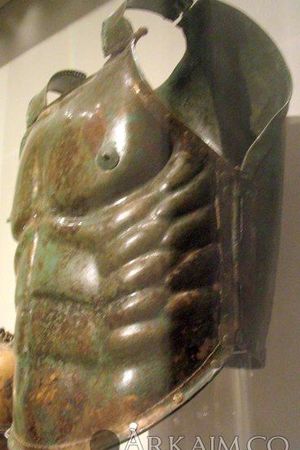 Lorica musculata. Lanuvium's warrior tomb. Bronze, there are traces of leather and linen. Maximum height: 40.8 cm, shoulders 50 cm, width: 30 cm, overall thickness: 26 cm. 490-480 year BCE
Lorica musculata. Lanuvium's warrior tomb. Bronze, there are traces of leather and linen. Maximum height: 40.8 cm, shoulders 50 cm, width: 30 cm, overall thickness: 26 cm. 490-480 year BCE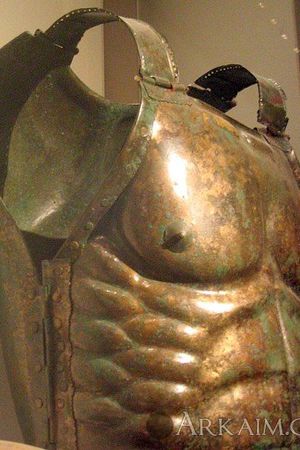 Lorica musculata. Lanuvium's warrior tomb. Bronze, there are traces of leather and linen. Maximum height: 40.8 cm, shoulders 50 cm, width: 30 cm, overall thickness: 26 cm. 490-480 year BCE
Lorica musculata. Lanuvium's warrior tomb. Bronze, there are traces of leather and linen. Maximum height: 40.8 cm, shoulders 50 cm, width: 30 cm, overall thickness: 26 cm. 490-480 year BCE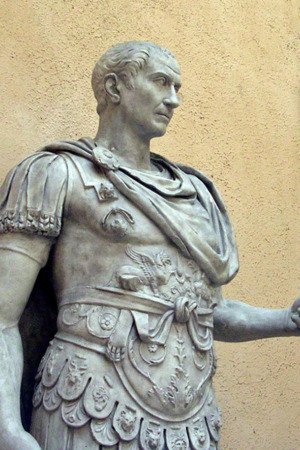 Gaius Julius Caesar's statue as an emperor. Rome, Museum of Roman Civilization. Inv. No. MCK 194. The beginning of the 2nd century CE (the statue was created during Trajan)
Gaius Julius Caesar's statue as an emperor. Rome, Museum of Roman Civilization. Inv. No. MCK 194. The beginning of the 2nd century CE (the statue was created during Trajan)